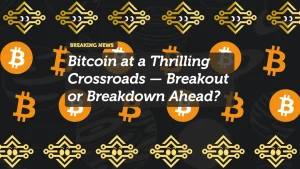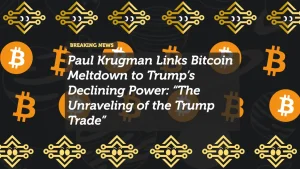
Bitcoin’s Quantum Risk: Martin Shkreli Warns Shor’s Algorithm Could Crack Crypto Security
The world of crypto has survived forks, bans, and bear markets — but quantum computing might be its final boss.
This week, former pharmaceutical executive and convicted investor Martin Shkreli — known for his controversial insights and outspoken takes — resurfaced on X (formerly Twitter) to issue a stark warning: “Quantum computing isn’t science fiction anymore. Shor’s algorithm is the real Bitcoin killer.”
The remark instantly reignited debate about Bitcoin’s post-quantum security and whether current cryptography could withstand the next computing revolution.
Shor’s Algorithm: The Quiet Threat Behind Quantum Hype
At the heart of the warning is Shor’s algorithm, a mathematical breakthrough developed by mathematician Peter Shor in 1994.
Shor’s algorithm, if implemented on a sufficiently powerful quantum computer, could factor large prime numbers exponentially faster than classical machines — a process that underpins the RSA and elliptic curve cryptography (ECC) used to secure Bitcoin, Ethereum, and most blockchains today.
“Every public key in the Bitcoin network is a potential target,” said Dr. David Chaum, cryptography pioneer and founder of Elixxir. “If a quantum computer with enough qubits ran Shor’s algorithm, it could derive private keys from public ones — breaking the fundamental trust model of crypto.”
Bitcoin uses the secp256k1 elliptic curve for its digital signatures, a system considered mathematically unbreakable with classical hardware. But Shor’s quantum factoring method changes the equation: it could, in theory, compute the discrete logarithm problem in polynomial time.
In plain English — the lock and key system that makes Bitcoin secure could be picked instantly once quantum hardware reaches sufficient scale.
When Does the Quantum Clock Strike Midnight?
Estimates on when this threat becomes real vary wildly.
IBM, Google, and several Chinese labs have made major breakthroughs in quantum supremacy — solving specific problems faster than classical supercomputers — but today’s quantum processors max out around 1,000 logical qubits, with most experts suggesting that breaking Bitcoin would require at least 1 million error-corrected qubits.
Shkreli, however, argues that software progress, not hardware limits, may accelerate the timeline:
“Everyone’s watching hardware, but algorithms evolve faster,” Shkreli said. “Quantum error correction and hybrid computing models will close the gap sooner than people think — maybe inside this decade.”
His comments echo warnings from NSA researchers and NIST cryptographers, who have been racing to finalize post-quantum encryption standards to future-proof digital communications — including blockchain protocols.
Bitcoin Developers Are Paying Attention
The Bitcoin Core development community has quietly acknowledged the issue for years. Core maintainers have discussed the potential to migrate Bitcoin’s signature scheme from ECDSA to quantum-resistant lattice-based cryptography, such as CRYSTALS-Dilithium or Falcon — both candidates in the U.S. NIST post-quantum cryptography program.
“It’s not something that breaks Bitcoin overnight,” said Peter Todd, Bitcoin Core developer. “But it’s something we need to be ready to transition for, the same way the internet moved from SHA-1 to SHA-256.”
Other chains are already experimenting with quantum-secure protocols:
- Quantum Resistant Ledger (QRL) launched in 2018 using XMSS (eXtended Merkle Signature Scheme).
- Ethereum researchers have proposed integrating lattice-based and hash-based signatures for long-term security.
- Cardano has a dedicated research stream on “quantum-proof” staking architecture.
Still, the cost of migrating Bitcoin’s global infrastructure — wallets, exchanges, payment processors, and millions of embedded nodes — would be monumental.
Crypto Markets Shrug — For Now
Despite Shkreli’s warning, markets barely reacted. Bitcoin traded around $111,400 on Friday, up 0.4% intraday.
Analysts say that’s typical: quantum threats remain long-term, while near-term price action is dominated by ETF flows, inflation data, and Federal Reserve policy.
However, some investors see opportunity in quantum-related projects. Tokens tied to decentralized security, encryption, and zero-knowledge proofs — like Aleph Zero (AZERO), QANplatform (QANX), and Secret Network (SCRT) — have all surged between 5% and 12% following renewed media coverage.
“It’s like climate change for crypto,” said Nick Newman, CEO of Casa. “Everyone knows it’s coming eventually, but nobody’s building their ark until it starts raining.”
The Quantum Arms Race Has Begun
Global governments are already preparing for “Q-Day” — the moment when a quantum computer can break existing encryption.
The U.S. National Quantum Initiative, the EU’s Quantum Flagship, and China’s Quantum Network Project have collectively poured over $50 billion into research and development.
Meanwhile, financial institutions, including JPMorgan Chase and Visa, have filed patents for quantum-secure blockchain architectures, anticipating the next wave of cryptographic upgrades.
Shkreli’s comments may sound alarmist, but they underscore a reality the crypto world can’t ignore: the quantum countdown has begun, and Bitcoin’s best defense may lie in evolving faster than the threat itself.
Conclusion: Prepare, Don’t Panic
For now, Bitcoin remains safe — Shor’s algorithm is a theoretical sword that no one yet wields. But as quantum research accelerates, the crypto industry faces a new kind of FUD: Future Unbreakable Dilemma.
The takeaway from Shkreli’s warning isn’t to abandon Bitcoin, but to invest in its next cryptographic leap. As the digital asset economy matures, post-quantum readiness could become not just a security feature — but a new competitive edge.
















